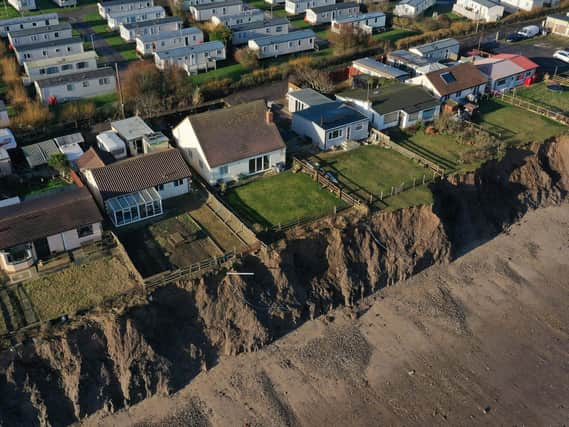Twenty-one houses and over 400 caravans on the East Riding coastline could fall into the sea by 2025


East Riding Council’s Environment and Regeneration Overview and Scrutiny Committee heard stretches of coast north and south of Withernsea had seen the fastest rates of erosion with some parts losing six metres.
Officers said Skirlington lost between one and two metres on average at the lower end of the scale as four East Riding homes threatened by erosion were demolished this year.
Advertisement
Hide AdAdvertisement
Hide AdAs many as 427 caravans and holiday chalets along the 85km stretch of coastline are also under threat in the run up to 2025, according to council forecasts.
Cllr John Whittle, ward member North Holderness on the coast, said the rate of erosion was “staggering”.
Cllr Whittle said: “If you look at the whole of the East Riding coast, it’s a concern for all of us. The rate of erosion is staggering and the stress it places on coastal residents is enormous.”
Councillors heard the River Humber was forecast to rise by one metre during the next century which the Hessle Foreshore Tidal Defence Scheme, currently being built, is designed to address.
Advertisement
Hide AdAdvertisement
Hide AdThey added more than £88m would be spent on erosion and flood defence schemes under its current works plans which end in 2021.
But council officer Claire Hoskins said she expected residents would be encouraged to do more to protect themselves from flooding, adding the local authority could not “build its way out”.
Council officer Richard Jackson said while the council had already fortified large coastal towns such as Bridlington, “rapid” erosion was continuing elsewhere according to a survey from October to March.
He added council visits to under threat communities had been cut back due to coronavirus, meaning officers had to prioritise those most at risk.
Advertisement
Hide AdAdvertisement
Hide AdMr Jackson said: “We’ve continued to work with residents since January, we demolished four properties at risks and ensured affected residents were relocated.
“Despite coronavirus we’ve continued to work with those most at risk, including in Skipsea and Withernsea.
“But we still have a number of residential, commercial and transport assets at risk in both the short and long term.
“Some parts of the coast are eroding particularly rapidly and we’re working on defence schemes in those areas, such as in Withernsea which is set to be finished in mid-November.
Advertisement
Hide AdAdvertisement
Hide Ad“We were initially projecting that 234 homes would be under threat by 2055, but once the Withernsea scheme is finished that number should be reduced by 70.
“We also expect it to protect around 250 holiday chalets and caravans.”
Officer Jeremy Pickles said finite resources meant the council had to focus on coastal areas with the highest populations and amount of business activity.
Council officer Ms Hoskins said several projects designed to protect against flooding inland had been completed, with a further £42m earmarked for schemes in the next programme from 2021.
Advertisement
Hide AdAdvertisement
Hide AdBut she added floods in Snaith and East Cowick in March were a reminder that climate change would increase its likelihood in the coming decades.
The officer said: “Snaith and East Cowick are still feeling the aftermath of those floods and the risk of them happening is going to increase in the next 100 to 150 years.
“The council has a total of 65 measures to address flooding and coastal risks, with 28 completed, 29 outstanding and nine yet to start.
“The council has the biggest capital programme for flood defences outside of London, and are efforts are expected to reduce the risk of flooding to 24,000 properties, equivalent to 55,500 residents, as well as protecting more than 1,000 businesses.
Advertisement
Hide AdAdvertisement
Hide Ad“Works at Withernsea and on the River Humber at the Hessle Foreshore Tidal Defence Scheme are coming along well.
“But we can’t always protect all households against all floods, and I think we’ll see a shift in the way we approach flood risk.
“We’ll be encouraging communities to come up with their own flood risk plans so they’re ready if one happens.
“Residents can also use grass or gravel on their drives instead of non-permeable surfaces such as tarmac, fit green roofs and put plugs further up walls rather than at floor level.
“We’re already trying to encourage residents to protect themselves, because we can’t protect everything from all risks and we can’t build our way out of these problems.”